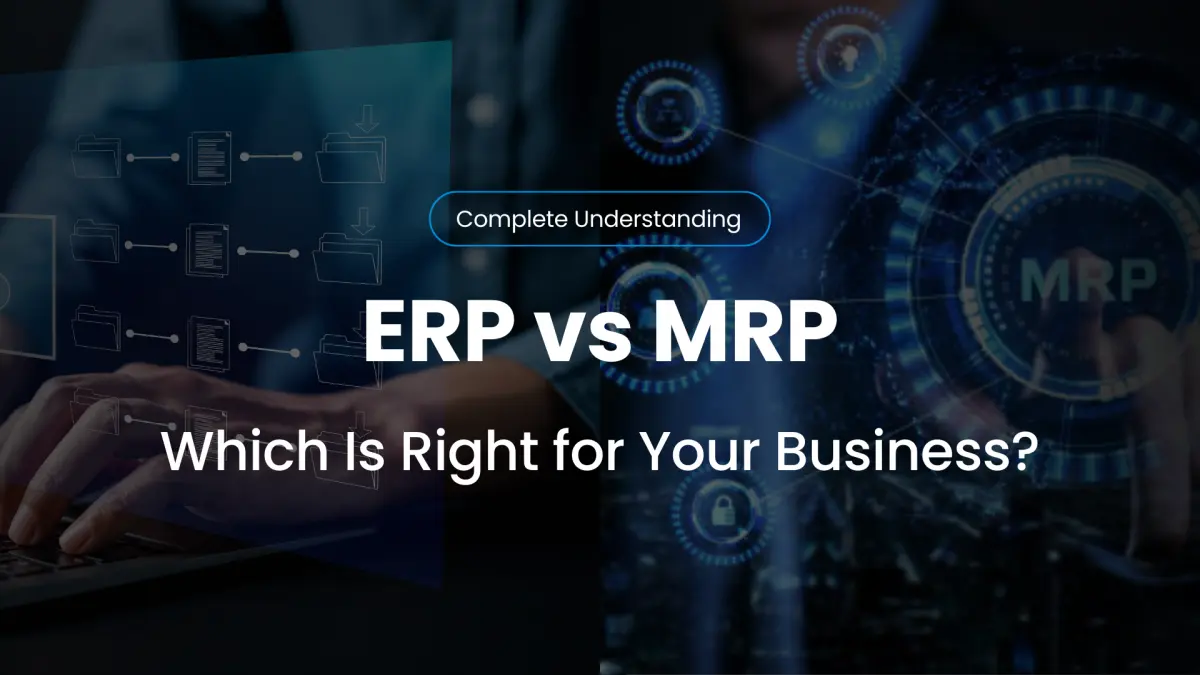Choosing the right software to manage your operations can make or break your business. In this article, we’ll dive into ERP vs MRP, highlighting their key differences, unique benefits, and how to decide which one fits your needs best.
Whether you’re running a growing manufacturing business or looking to streamline operations, understanding ERP and MRP systems is crucial for making an informed choice. Let’s explore how each solution can support your goals.
What Are MRP and ERP Systems?
1. What is Material Requirements Planning?
Material Requirements Planning (MRP) is a production planning and inventory control system designed specifically to manage manufacturing operations. MRP modules focus on three core components:
- Inventory management: Tracking materials and ensuring optimal stock levels
- BOM management: Maintaining accurate Bills of Materials for production
- Production scheduling: Coordinating manufacturing activities to meet demand
MRP systems help manufacturers determine what materials to order, how much to order, and when to place those orders. They’re essentially specialized tools for optimizing the production planning process.
2. What is Enterprise Resource Planning?
Enterprise Resource Planning (ERP) represents a more comprehensive approach to business management. An ERP software functions as an integrated system that manages business-wide functions including:
- Finance and accounting
- Human resources
- Supply chain management
- Customer relationship management
- Manufacturing and production
- And much more
ERP systems connect various business processes across departments to create a unified information ecosystem where data flows seamlessly throughout the organization.
Key Differences Between MRP and ERP
1. Scope and Functionality
The fundamental difference between ERP vs MRP lies in their scope:
- MRP Systems: Focus primarily on production planning and inventory control within manufacturing operations
- ERP Systems: Provide comprehensive coverage of all business processes across the entire organization
While MRP concentrates on production-specific challenges, ERP addresses enterprise-wide integration needs.
2. Data Accessibility
How each system handles information represents another key distinction:
- MRP: Typically works with operational data specific to manufacturing
- ERP: Delivers real-time data across all departments, enabling more effective decision-making tools
The ability to access up-to-date information across the organization gives ERP systems a significant advantage for companies requiring cross-departmental integration.
3. Scalability and Flexibility
Growth considerations also differentiate these systems:
- ERP: Offers scalable ERP system architecture that supports business expansion, including multi-site management capabilities
- MRP: Works well for stable, smaller manufacturing operations but may struggle to adapt to complex, growing enterprises
Benefits of ERP Systems
1. Operational Efficiency
Modern ERP software streamlines operations by:
- Automating routine tasks
- Standardizing business processes
- Reducing manual data entry and associated errors
- Creating efficient workflows across departments
2. Advanced Analytics and Reporting
Data-driven decision making is enhanced through advanced analytics capabilities, real-time dashboards, and even AI-powered ERP features that deliver predictive analysis for more accurate forecasting:
- Comprehensive data analytics capabilities
- Real-time dashboard reporting
- Performance metrics tracking
- Predictive analysis for forecasting demand
3. Centralized Data and Collaboration
ERP facilitates collaboration by:
- Breaking down departmental information silos
- Providing a single source of truth for business data
- Enabling cross-departmental integration
- Improving communication between teams
4. Future Scalability
A well-implemented ERP system grows with the business:
- Supporting expansion to multiple locations
- Adapting to increased transaction volumes
- Accommodating new business units or acquisitions
- Enabling global operations management
Features and Strengths of MRP Systems
1. Forecasting and Demand Planning
MRP excels at production forecasting by:
- Analyzing historical sales data
- Incorporating seasonal trends
- Calculating material requirements based on forecasting demand
- Planning production capacity needs
2. Inventory and Material Control
Effective inventory control is a core MRP strength:
- Optimizing stock levels to minimize costs
- Preventing stockouts and overstock situations
- Tracking material usage and waste
- Managing reorder points and safety stock
3. Scheduling and Production Optimization
MRP systems enhance production scheduling through:
- Capacity planning
- Resource allocation
- Production timeline optimization
- Work center load balancing
4. Waste Reduction
Manufacturing efficiency improves as MRP helps:
- Minimize material waste
- Reduce production bottlenecks
- Optimize batch sizes
- Improve overall resource utilization
The Evolution from MRP to ERP
1. The Birth of MRP (1960s)
The concept of Material Requirements Planning emerged in the 1960s as manufacturers sought better ways to manage production planning and inventory control. Early MRP systems focused solely on calculating material requirements based on production schedules.
2. MRP II and Expansion in the 1970s–1980s
MRP II (Manufacturing Resource Planning) expanded the original concept to include additional manufacturing operations elements such as capacity planning, shop floor control, and financial planning.
3. Emergence of ERP in the 1990s
As businesses recognized the value of integrated information systems, ERP emerged to connect manufacturing with other business functions. This evolution represented a significant shift toward enterprise-wide integration.
4. Modern ERP Systems with Built-in MRP
Today’s manufacturing ERP solutions typically include robust MRP modules as standard components. This integration offers the specialized benefits of MRP within the broader context of enterprise-wide management.
When to Choose ERP or MRP
Ideal Scenarios for ERP
Organizations should consider ERP when they:
- Operate complex, multi-department businesses
- Need multi-site management capabilities
- Require integrated supply chain visibility
- Plan for significant growth
- Seek improved cross-departmental coordination—even in cloud environments comparing ERP vs MRP cloud solutions
Ideal Scenarios for MRP
MRP may be the better choice when:
- The business focuses primarily on manufacturing operations
- Budget constraints make full ERP implementation prohibitive
- Production planning and inventory management are the primary challenges
- The organization structure is relatively simple and stable
Integration Capabilities Comparison
1. ERP: Cross-Department Integration
ERP systems excel at connecting different business functions:
- Finance integrates with operations
- Sales communicates with production
- Purchasing coordinates with inventory
- Human resources aligns with project management
2. MRP: Production-Focused Modules
MRP offers specialized integration within manufacturing:
- BOM management connects with inventory
- Production scheduling aligns with capacity
- Purchasing links to material requirements
- Quality control integrates with production data
3. Transitioning from MRP to ERP
Many companies follow a phased approach:
- Start with MRP modules to address immediate production needs
- Gradually implement additional ERP components
- Eventually transition to a complete integrated system
- Maintain manufacturing focus while expanding capabilities
Top ERP Systems with Strong MRP Capabilities
1. NetSuite ERP
NetSuite offers a cloud-based ERP solution with robust manufacturing capabilities, including production planning, inventory control, and supply chain management.
2. Infor CloudSuite Industrial Enterprise
Infor delivers industry-specific ERP software with comprehensive manufacturing modules designed for different production environments.
3. Acumatica Cloud ERP
Acumatica provides flexible manufacturing ERP options with strong MRP functionality and scalable implementation approaches.
4. Epicor Kinetic
Epicor focuses specifically on manufacturing businesses with extensive production planning and scheduling capabilities.
Cost Comparison: ERP vs MRP
Initial Costs and Licensing
The cost of ERP typically exceeds MRP investment:
- ERP software licenses cover more modules and users
- Implementation services are more extensive
- Hardware requirements may be more significant
- Training costs extend across more departments
ROI and Long-Term Value
Despite higher initial expenses, ERP often delivers superior returns:
- Broader process improvements generate greater savings
- Cross-functional efficiencies multiply benefits
- Enterprise-wide visibility enhances decision-making
- Scalability supports long-term growth
Hidden Costs and Upgrades
Both systems involve ongoing considerations:
- Maintenance and support fees
- Upgrade costs and migration expenses
- Additional module implementations
- Integration with other systems
How to Select the Right System for Your Business
1. Using ERP Comparison Tools
Various resources help evaluate options:
- Feature comparison matrices
- Industry analyst reports
- Vendor demonstration scorecards
- Customer review platforms
2. Understanding Your Business Needs
Effective selection requires:
- Process mapping current workflows
- Identifying pain points and bottlenecks
- Defining must-have vs. nice-to-have features
- Aligning system capabilities with strategic goals
3. Requesting Free Demos
Hands-on evaluation provides clarity:
- Schedule demonstrations with multiple vendors
- Prepare specific scenarios to test
- Involve end-users in the evaluation process
- Ask about implementation methodologies
Frequently Asked Questions (FAQs)
Can a small business benefit from ERP?
Yes, though traditionally associated with larger enterprises, many cloud-based ERP solutions now offer scaled options suitable for small businesses. The key is selecting a right-sized system that addresses specific needs without excessive complexity.
Are MRP systems still relevant today?
Absolutely. While standalone MRP systems have become less common, the core functionality remains essential for manufacturing operations and is typically incorporated into modern ERP platforms as specialized modules.
What is MRP II?
MRP II (Manufacturing Resource Planning) expanded on original MRP concepts to include additional functions like shop floor control, capacity planning, and financial management. It represents an evolutionary step between traditional MRP and modern ERP systems.
How long does ERP implementation take?
Implementation timeframes vary significantly based on complexity, scope, and organizational readiness. Small to mid-sized ERP implementations typically require 3-6 months, while larger enterprise deployments may take 12-24 months or longer.
What is the cost difference between ERP and MRP?
The cost of ERP typically ranges from 1.5 to 3 times that of comparable MRP systems due to broader functionality, more extensive implementation requirements, and wider organizational impact. However, this varies widely depending on specific solutions and deployment methods.
Conclusion
The choice between MRP and ERP systems ultimately depends on organizational needs, complexity, and growth plans. While MRP focuses efficiently on production planning and inventory control within manufacturing, ERP offers broader business process integration across the entire enterprise.
At Infintrix Technologies, we help businesses implement flexible ERP solutions that include powerful MRP capabilities—combining deep manufacturing insights with seamless enterprise coordination. This integrated approach is especially valuable for growing companies looking to scale without sacrificing control or visibility.
Whatever system is chosen, long-term success depends on thoughtful implementation, user adoption, and continuous optimization to support evolving business goals.

